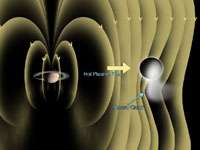Cassini confirms a dynamic atmosphere at Saturn’s moon Enceladus

The latest close flyby of Saturn’s icy moon Enceladus by NASA’s Cassini spacecraft confirms that the moon has a significant, extended and dynamic atmosphere. The flyby, which took place on 14th July 2005, was Cassini’s lowest altitude flyby of any object to date, a mere 173 kilometres (108 miles) above the surface of Enceladus.
Image: This artist concept shows the detection of an dynamic atmosphere on Saturn's icy moon Enceladus. The Cassini magnetometer instrument is designed to measure the magnitude and direction of the magnetic fields of Saturn and its moons. During Cassini's three close flybys of Enceladus- Feb. 17, March 9 and July 14-the instrument detected a bending of the magnetic field around Enceladus due to electric currents generated by the interaction of atmospheric particles and the magnetosphere of Saturn.
The graphic shows the magnetic field observed by Cassini as well as the predicted neutral cloud being vented from the south pole. Cassini's magnetometer observed bending of the magnetic field consistent with its draping around a conducting object, which indicates that the Saturnian plasma is being diverted away from an extended atmosphere.
Credit: NASA/JPL
The 500 km diameter moon Enceladus is a very bright icy moon at a distance of 4 Saturn radii away from Saturn. It has long been associated with the formation of the E ring, Saturn’s outermost ring. The first two more distant flybys of Enceladus on February 17th at an altitude of 1,167 kilometres (725 miles), and on March 9th, 500 kilometres (310 miles) above Enceladus’ surface had shown draping or bending of the magnetic field around the moon, revealing that Enceladus was acting as a large obstacle to the flow of plasma and magnetic field from Saturn by its extended asymmetric atmosphere.
The recent close flyby confirms and extends the observations from the two more distant flybys which took place earlier this year. Although no other instruments on the Cassini spacecraft had detected evidence of this atmosphere on the first two flybys, on the basis of the magnetometer [MAG] instrument observations alone a decision was made to modify the spacecraft trajectory for the 14th July encounter to fly much closer to the surface of Enceladus.
Professor Michele Dougherty from Imperial College London, who is Principal Investigator on the Magnetometer instrument on Cassini, says “These latest observations are very exciting, they confirm the existence of an atmosphere which we predicted from the distant earlier flybys and they will also allow us to gain a much better understanding of the processes taking place which are producing this very exotic atmosphere.”
Observations from numerous instruments now confirm what MAG was able to see from a great distance. Not only is the magnetic field even more strongly bent around the atmospheric obstacle connected to the moon but the other instruments also detected the presence of the atmosphere. The magnetic data also suggests that the atmosphere is not symmetric and may be arising from a comet-like jet from the southern hemisphere. Also the spacecraft passed right through the electric current carrying region associated with the atmospheric interaction.


















